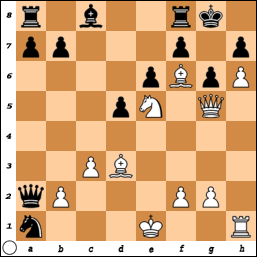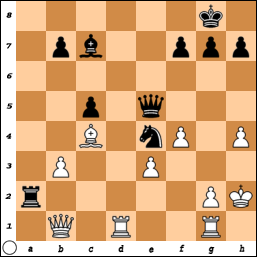
Ashley-N.N., New York 2013
9 board Blindfold Simultaneous Exhibition
White to move and mate in 3

Ashley-N.N., New York 2013
9 board Blindfold Simultaneous Exhibition
White to move and mate in 3

Cohen/Ashley 2013, Black to move and mate in 3.
It’s not often that I see something in chess that I’ve never seen before. When it happens, it’s always a pleasant surprise that brings a smile to my face and reminds me how infinite the royal game really is. This mate comes by way of one of my top students, 10 year old Jameson Cohen, who recently pulled in off in an actual game. Once I saw it, I knew we had to make a puzzle out of it, so he and I sat down and co-created this mate in 3. Is Jameson a future Sam Loyd in the making?
1…Qf4+! 2.gxf4 Bxf4+ 3.Kh3
3.Kh1 is a standard mate we’ve all seen after 3…Nf2#
3…Nf2#!
I cannot recall ever seeing this final position, either in a game or in a variation to a game. If anyone else has seen a game that in someway involves this rare gemstone of a set-up, please let us know! Until then, this might be dubbed “Cohen’s mate!”
It’s hard to imagine the knight’s final resting place in this study. One thing for sure: when you see it, you will very impressed by the work ethic of the piece!
My first DVD talks about the secret every GM knows, that to defeat a sophisticated opponent you must take direct advantage of the drawbacks in each of his/her moves.
I recently discovered a new data-mining technique that I’ve been employing over the last year to cull positions from my over 4 million game database. It has allowed me find hundreds of incredible and instructive combinations and ideas to share with my students and potentially for future books or DVDs. Here is one my favorites:

Montheard-Toulzac 2005, White to move and win
Black’s last move 24…h4 traps White’s queen, and might cause most players to panic. White remained calm and played a logical move 25.Bxe5, and, even went on to win the game due to a serious error by his opponent(see below). However, White could have gone down in history with the mind-blowing 25.Nxf6!!
It’s hard to wrap your mind around such a move. At first blush, it’s not obvious what the point is. Only through careful analysis does it all become clear.
Let’s start with 25…hxg3, accepting the queen. Now White plays the cold-bloodied 26.Nxg4! going down a queen for a mere knight. However, a brief look is enough to see that White’s ostensibly weaker forces are a perfect picture of powerful centralization. The threat is now 27.Bxe5+ (or, even better, 27.Rxe5!), winning back the queen with interest and maintaining a blistering attack on the king. None of Black’s moves will help.
These lines are short and sweet and prove that the queen is untouchable. Despite their brevity, it takes a lot of creativity, calculating skills and clarity of vision to see that the queen sac is simply crushing. Did I say queen sac? Actually, 25.Nxf6!! is a knight sac. Let’s see what happens if Black takes the knight instead:
25…Bxf6 (25…Nxf6 26.Qxg5 is over) 26.Qf4!
A cool waiting move. Black is completely helpless against all the threats to capture one of his three minor pieces, starting with the knight on g4. Black’s main attempts both fail:
All these variations belong to the calculating powers of super GM’s (or computer programs!). As I mentioned earlier, from the diagram White played the more mortal move 25.Bxe5. (It should be noted that 25.Nxg5 does not work because of 25…hxg3 26.Ne6+ Kh6! 27.Nxc7 Rxc7 28.hxg4? Rch7!! when White will lose!)The game proceeded with 25…Nxe5 26.Nxg5 hxg3 27.Ne6+ Kh6?
Correct was 27…Kg8! 28.Nxc7 Rxc7 29.Rxf6 Kg7! with sudden equality.
28.Re4!
White is a master after all! This in-between mate threat wins the game.
28…Ng4
28…g5 29.Rxf6+ Ng6 30.Nxc7 Rxc7 31.Ree6 wins
29.Rxg4 Qe5
There is no other way to stop mate.
30.Rxg6+
Winning, but more tasty was 30.Rh4+! Qh5 31.Rxh5+! Kxh5 (31…gxh5 32.Rxf6 mate) 32.Be2+ Kh6 33.Rf4! g5 34.Rxf6 mate.
30…Kh5 31.Nf4+ Kh4
31…Qxf4 32.Rxf4 is just an extra piece.
32.Rg4 mate
1–0